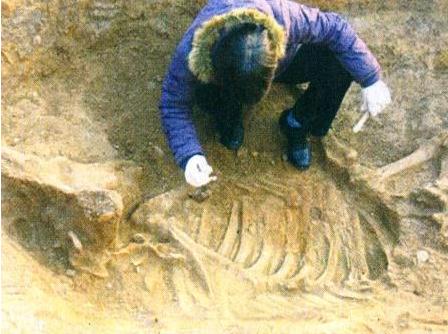Excavation of a Large-sized Ritual Site of the Early Western Zhou Period in Luoyang
In a salvaging excavation during February 2009 to June 2010, Luoyang Archaeological Team discovered a ritual site of the early Western Zhou period with an area of 1,500 m². The excavation yielded important results including ritual pits, ash pits, tombs, ditches, and abundant ceramics and bone objects.
The massive cultural deposits in the site are divided into six layers, mainly assigned to Tang Dynasty and the Western Zhou period. The Western Zhou ruins include 90 pits, 1 ditch and 20 tombs. Among them the 37 ritual pits and the ditch are of great significance.

Most ash pits are in oval, rectangular and irregular form, with the opening 0.9-7.6 m in diameter, the bottom 0.8-7.5 m in diameter and 0.1-2.9 m in depth. 37 pits have served for ritual use. There is a platform made for burning ritual. 29 ritual pits remain complete animal bones; 3 ritual pits contain human bones indicating unnatural deaths; 5 pits buried piles of bone pieces. According to the combination of contained bones, these pits fall into following categories: horse pits, dog pits, cattle pits, pig pits, horse-human pits, pig-human pits, horse-pig pits, pig-cattle pits, chariot-horse pits, human-cattle-dog pits and pits with bone pieces.

All these pits probably served for the burying ritual, with each one containing one or two kinds of animals. For example the pit H36, an oval-shaped pit, buried with a complete horse skeleton. The burning ritual was a ceremony to burn objects like jade Gui and animals on firewood so that to bring their spirits to the heaven for serving the god. Two remains of this kind have been found in the site. One is a platform overlapped by other remains, and the other is in the form of a nearly round pit which contains ceramic shards, burned bones and earth, and a layer of charcoal debris at the bottom. In the middle of its bottom there is a round pit with slant wall and flat bottom, measuring 0.9 m in diameter and 0.3 m in depth. The wall of the pit has been leveled, and the ashes inside are indicative of a burning ceremony.

The ditch of the Western Zhou period is about 4 m wide at the opening, 0.8 m wide at the bottom, and 3.8-4.2 m deep. The unclosed part is 52 m long, with the west end higher than the east. In the ditch sediment deposited by flowing water could be seen, which contains ceramic shards of Li tripod, Gui vessel and pot.
The tombs are all in form of rectangular shaft pit. Two of them are in south-north direction and the others in east-west direction. The largest one measures 4.1 m long, 2.2 m wide and 9 m deep, and the smallest one 1.4 m long, 0.4 m wide and 0.18 m deep. Four tombs are buried with objects including ceramic Li tripods, Gui vessels, pots, bronze arrow heads, lead daggers and jade pieces.

The unearthed objects are mainly ceramics like Li tripods, Gui vessels, pots, basins Zeng steamers and pats. Other findings include bronze knifes, stone axes, bone awls and bone hairpins, as well as a piece of oracle bone.
The excavation reveals that it is a ritual site of the early Western Zhou period with a large area and rich contents. It is really a great discovery in the field of the Western Zhou archaeology. The findings provide not only important materials for studying the ritual system of that period, but also a significant clue to understanding the size, plan and form of the Luoyi city in the Western Zhou Dynasty. (Translator: Tong Tao)

